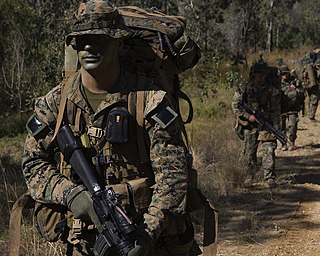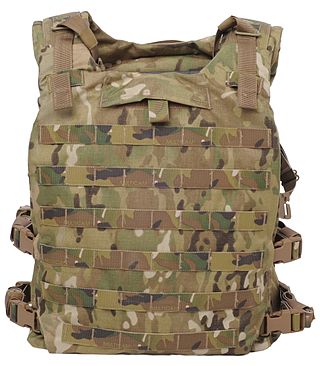
Modular Lightweight Load-carrying Equipment, or MOLLE (pronounced MOL-lee,, is the current generation of load-bearing equipment and backpacks used by a number of NATO armed forces, especially the British Army and the United States Army.

Personnel Armor System for Ground Troops is a combat helmet and ballistic vest that was used by the United States military from the early 1980s until the early or mid-2000s, when the helmet and vest were succeeded by the Lightweight Helmet (LWH), Modular Integrated Communications Helmet (MICH), and Interceptor Body Armor (IBA) respectively.

The Small Arms Protective Insert (SAPI) is a ceramic ballistic plate used by the United States Armed Forces. It was first used in the Ranger Body Armor and Interceptor Body Armor, both are ballistic vests. It is now also used in the Improved Outer Tactical Vest as well as the Modular Tactical Vest, in addition to commercially available "plate carriers". The Kevlar Interceptor vest itself is designed to stop projectiles up to and including 9×19mm Parabellum submachine gun rounds, in addition to fragmentation. To protect against higher-velocity rifle rounds, SAPI plates are needed.

Ceradyne, Incorporated is a wholly owned subsidiary of the British company, Avon Rubber. Ceradyne, Inc. is a manufacturer of advanced ceramic systems and components and involved in many technical industries including nuclear power, oil and gas, solar energy, automotive, and defense. It is traded on the NASDAQ Stock Market.

Federal Prison Industries, Inc. (FPI), doing business as UNICOR since 1977, is a corporation wholly owned by the United States government. It was created in 1934 as a prison labor program within the Federal Bureau of Prisons.

The improved load-bearing equipment (ILBE) is a United States Marine Corps program that had included individual load carriage equipment, individual hydration systems and individual water purification.

The Modular Tactical Vest is a ballistic vest originally adopted by the United States Marine Corps in 2006. The MTV was designed as a solution to shortcomings in the Interceptor Body Armor (IBA) and was selected after a rigorous proposal and examination process by the Marine Corps. The MTV provides better protection levels than the IBA, although it uses the same Small Arms Protective Insert (SAPI) plates. The MTV weighs 30 pounds (14 kg), three pounds more than the IBA, but is designed to more effectively distribute its weight throughout the wearer's torso.

CIRAS is a modular protective vest designed for US Special Operations Forces by Eagle Industries. The vest is currently the new FSBE II system and has replaced the FSBE AAVs. It features PALS webbing, making it MOLLE-compatible and allowing the attachment of various pouches or accessories. Two versions of the vest are available, known as the "land" and "maritime" versions. The vest consists of front and rear panels with pockets for BALCS or SPEAR-cut soft armor panels and standard-issue SAPI plates. This gives the wearer up to NIJ Level IV protection on the front and back and Level IIIA protection on the sides. On the lower rear side of the front of the vest, there are two quick-releasable buckles for attaching groin protection. The wearer's sides are covered by an external cummerbund, which is also covered with PALS webbing. The vest body is constructed of 1000-denier Cordura Nylon, and the interior is lined with heavy-duty mesh to aid in cooling the wearer.

Ranger Body Armor (RBA) is a US military-issue ballistic vest that was designed for, and used chiefly by, US Army 75th Ranger Regiment operators ("Rangers") in the 1990s and 2000s. The RBA system has since been replaced by other specialized body armor systems adopted by the United States Special Operations Command (USSOCOM).

The Army Combat Shirt (ACS) is a flame-resistant shirt developed and used by the United States Army as a supplementary addition to the Army Combat Uniform (ACU). The ACS is a stand-alone shirt designed specifically for use with Improved Outer Tactical Vest (IOTV) in warm and hot weather instead of the blouse, and was introduced in 2007. It is intended to greatly increase user comfort through the use of lightweight, moisture-wicking, and breathable fabrics. The ACS was created in conjunction with the USMC's Flame Resistant Organizational Gear (FROG). The ACS, in conjunction with the Fire Resistant ACU (FRACU) trousers, provides head-to-toe protection against burns.

The Improved Outer Tactical Vest (IOTV) is an enhanced version of, and a replacement for, the older Outer Tactical Vest (OTV) component of the Interceptor Multi-Threat Body Armor System, as fielded by the United States Army beginning in the mid-2000s. The IOTV is compatible with the Deltoid and Axillary Protector System (DAPS) components, ESAPI, Enhanced Side Ballistic Inserts (ESBI), as well as the OTV's groin protector. A flame-resistant standalone shirt, the Army Combat Shirt (ACS), was designed in the late 2000s specifically for use with the IOTV.

The Pouch Attachment Ladder System or PALS is a grid of webbing invented and patented by United States Army Natick Soldier Research, Development and Engineering Center used to attach smaller equipment onto load-bearing platforms, such as vests and backpacks. It was first used on MOLLE rucksacks, but is now found on a variety of tactical equipment, such as the U.S. Improved Outer Tactical Vest, Interceptor body armor, USMC Improved Load Bearing Equipment backpack and Modular Tactical Vest. It is used to attach items such as holsters, magazine pouches, radio pouches, knife sheathes, and other gear. A wide variety of pouches are commercially available, allowing soldiers to customize their kit. There is also a variety of attachment methods including the Alice Clip, the Natick snap, and soft, interwoven straps. The PALS system has begun to be adopted by other forces, such as the British Army, who use it on their Osprey body armor.

Tactical Vest Antenna System (TVAS) is a type of wearable antenna designed for use by the United States Armed Forces. It is claimed that troops equipped with the TVAS are more effective than those equipped with conventional whip antennas due to better concealment of the equipment and improved mobility of the operator. TVAS was developed by Wearable Antenna Technologies Inc. in early 2008.
The PRU-70/P22P-18 (V) is an Armored Survival Vest (ASV) that is intended for aircrews. It was designed by Naval Air Systems Command Human Systems Division. The vests are manufactured by Peckham Vocational Industries in Michigan and are used by Navy and Marine aircrew in Iraq and Afghanistan.
The Amphibious Assault Vest, Quick-Release, or FSBE AAV QR, is a light-weight assault vest system that incorporates both protection and cargo retention. Protection includes soft armor coupled with hard ballistic inserts. Cargo retention capabilities include various pouches and pockets attached via standard PALS webbing. The entire FSBE kit includes the vest body, a throat protector, a groin protector and an assortment of load bearing pouches. A fully loaded vest with armor plates can prove quite heavy, and is typically used only in high-risk direct action (DA) missions.

The Soldier Plate Carrier System (SPCS), known commercially as the KDH Magnum TAC-1, is a plate carrier developed for the U.S. Army which provides protection in accordance with if not greater than, the Improved Outer Tactical Vest. The SPCS is a lighter alternative to the IOTV, with increased mobility and comfort. The MSV, part of the US Army's SPS, is intended to replace all currently fielded body armor systems.

The Scalable Plate Carrier (SPC) is a plate carrier used by the United States Marine Corps as an alternative to the heavier Modular Tactical Vest (MTV).
The Modular Body Armor Vest (MBAV) is a bullet-proof vest made by Eagle Industries and used by the United States military. The vest is standard issue for many members of the United States special operations forces including the 75th Ranger Regiment. 10,000 vests were deployed on an interim basis with the U.S. Marine Corps while it developed the Scalable Plate Carrier. The vest was also evaluated by the U.S. Army.

The Modular Scalable Vest (MSV) is a bullet-resistant vest that has been introduced by the United States Armed Forces in 2018.






























